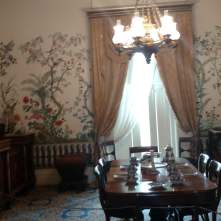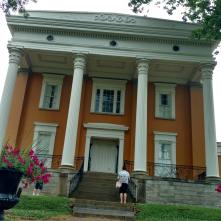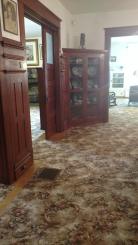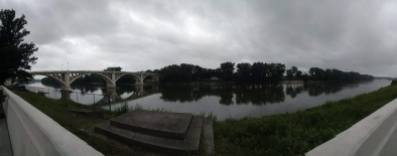I wrote a post about a month ago telling you all about the sites around Indiana and their importance to Indiana history (Read about those here). Well, I’m writing today to tell you that I’ve completed my trips! I had a friend go with me to all of them, and she and I had an amazing time. I want to tell you today about those sites, but not like I did the first time, where I just told you what to expect.
Going in, I wasn’t entirely sure what to expect from all these places. I knew the information that I wrote a month ago, but that was it. I did not know that there would be multiple times I would get lost or not sure where to go. I did not know that it would be a lot of early mornings and some late nights. All the tour guides I interacted with were knowledgeable about their site. Let’s just dive into the trips. (In the first post, I did the sites in alphabetical order. This time, I’m going to do them in order of trips taken. Unless otherwise noted, all pictures belong to me).
- Trip 1
- T.C. Steele- T.C. Steele was a painter who liked to paint en plain aire (outside). But he and his wife still needed somewhere to live. So he built her “The House of the Singing Winds” as her wedding present. However, while Steele may have been an excellent painter, he was not an architect by any means. As a result, the Steeles continuously updated their house, by adding on or renovating. Also, his “studio” looked more like a barn (that’s what the people knew how to build), but it was hardly ever used as a studio. There are grounds, a garden, and a couple trails to walk through the woods. Rating: 6/10

House of the Singing Winds (courtesy of https://cgi.soic.indiana.edu/~a110/PHP5/Archive09Fall/TCSteele/mypage.iu.edu/_pbordy/history.html )

T.C. Steele’s studio (courtesy of http://www.browncounty.com/listing/tc-steele-state-historic-site )
- T.C. Steele- T.C. Steele was a painter who liked to paint en plain aire (outside). But he and his wife still needed somewhere to live. So he built her “The House of the Singing Winds” as her wedding present. However, while Steele may have been an excellent painter, he was not an architect by any means. As a result, the Steeles continuously updated their house, by adding on or renovating. Also, his “studio” looked more like a barn (that’s what the people knew how to build), but it was hardly ever used as a studio. There are grounds, a garden, and a couple trails to walk through the woods. Rating: 6/10
- Trip 2
- Levi Coffin House- The Civil War is my favorite thing to study, so I was especially excited about this house. It did not really look that big from the outside, but it had an open floor plan and lots of extra rooms. It is understandable why this place was used in the Underground Railroad, and why it was so successful in helping runaway slaves find freedom. It was so successful, in fact, that this house was known as “The Grand Central Station of the Underground Railroad”. Every single runaway who made it to this house reached freedom. There were plenty of places to hide, and even an underground well from a spring that would decrease suspicion because Levi and Catherine Coffin did not have to leave the house to get water. And with all the people in their house at any one time, they needed a lot of water. Rating: 8/10.

Exterior of the house (courtesy of https://www.waynet.org/levicoffin/ )
- Levi Coffin House- The Civil War is my favorite thing to study, so I was especially excited about this house. It did not really look that big from the outside, but it had an open floor plan and lots of extra rooms. It is understandable why this place was used in the Underground Railroad, and why it was so successful in helping runaway slaves find freedom. It was so successful, in fact, that this house was known as “The Grand Central Station of the Underground Railroad”. Every single runaway who made it to this house reached freedom. There were plenty of places to hide, and even an underground well from a spring that would decrease suspicion because Levi and Catherine Coffin did not have to leave the house to get water. And with all the people in their house at any one time, they needed a lot of water. Rating: 8/10.
- Trip 2 (Continued)
- Whitewater Canal- After we left the Levi Coffin House in Fountain City, we headed down to Metamora. Metamora is this small town that you might miss if you don’t look out for it. The Whitewater Canal cuts the town in half. There is also a mill in town that does still work. The canal is definitely the coolest part though. You get to go on a boat that looks very similar to the ones used in the 1800s, and it’s powered the same way– pulled by horses! It’s not fast, but you get to go through a working aqueduct, the only one of its kind. The site was seriously cool on its own, but one thing that hampered the experience was the fact that my ice cream cone decided to be extra fragile and get everywhere! Rating: 6/10
- Trip 3
- Corydon Capitol- Did you know that there is a Civil War battle site in Indiana? Well, we kind of discovered it by accident on our way to Corydon. The site wasn’t open yet, so we killed a little time and discovered the battle site. That was amazing on its own because my goal is to visit all Civil War battlefields in my lifetime. The site itself was not that impressive, but it was the first one I can cross off my list. Then we went into Corydon itself. We actually caught the tail end of a tour because it does not start at the Corydon Capitol building. But we got to go inside the Capitol building and later tour the first governor of Indiana’s house (once Indiana became a state that is). Rating: 7/10
- Trip 3 (pt. 2)
- Culbertson Mansion- I love old mansions and houses. Once we left Corydon, we drove over to New Albany to tour the Culbertson mansion. For this tour, you have to ring the doorbell, and wait to be received. The tours usually start at the top of the hour and we got there about 15-20 minutes after the hour. When the tour guide opened the door, he asked if we were early or late. I said we were technically late, but he goes “Let’s pretend you’re early anyway”. So we got a private tour. This house is done in the Gothic Revival style (one of my favorites), and it’s also completely symmetrical in the structure and floor plan. Going through these really shows you how much money people at this time had, and it’s all so beautiful. This was definitely my favorite place. Rating: 9/10
- Trip 3 (pt. 3)
- Lanier Mansion- The Culbertson Mansion was not our only mansion tour of the day. We then traveled to Madison to visit the Lanier Mansion (pronounced La-NEAR). While this one was still cool, it was nowhere near as beautiful as the Culbertson Mansion. This one is done in a Greek Revival style like Southern Plantations. This one was also symmetrical to the point that there were dummy doors to make it look the same. I do love spiral staircases though, and this one was absolutely beautiful. Rating: 7/10
- Trip 4
- Limberlost- My friend and I took a couple of weeks off from traveling due to July 4th and a couple other things. So literally a month after our first trip, we did our fourth trip. This trip was all about Gene Stratton-Porter, Indiana’s most famous female author. We got to see both of her houses (she didn’t live in the same place all her life), and we actually did it in the order that she lived there. Her first house did not have as much technology of the time, and she used elements of her first house to draw on her second. Rating: 5/10

Outside of Limberlost Cabin (courtesy of http://www.bernein.com/business-directory/limberlost-state-historical-site/ ) - Gene Stratton Porter State Historic Site- The biggest differences between these two houses were that this second one had gardens and there was more technology. Again, Gene Stratton-Porter incorporated a lot of the same things from her Limberlost house into this one. This one was also directly on the Wabash River. Rating: 7/10
- Limberlost- My friend and I took a couple of weeks off from traveling due to July 4th and a couple other things. So literally a month after our first trip, we did our fourth trip. This trip was all about Gene Stratton-Porter, Indiana’s most famous female author. We got to see both of her houses (she didn’t live in the same place all her life), and we actually did it in the order that she lived there. Her first house did not have as much technology of the time, and she used elements of her first house to draw on her second. Rating: 5/10
- Trip 5
- Angel Mounds- This last trip was our longest. My friend and I actually got a hotel room for this trip . It was easier than going down south two separate times or preventing more than 7 hours of drive time in one day. We went to Angel Mounds first. The indoor exhibit giving the history and overview of the culture, but both my friend and I were expecting more from the Mounds themselves. I think we were maybe thinking along the lines of reconstructed civilization, but they were just mounds and plots of land. It was walking through an archaeological site without any of the buildings. Because the other sites were so cool, this kind of became my least favorite by default. Rating: 4/10
- Angel Mounds- This last trip was our longest. My friend and I actually got a hotel room for this trip . It was easier than going down south two separate times or preventing more than 7 hours of drive time in one day. We went to Angel Mounds first. The indoor exhibit giving the history and overview of the culture, but both my friend and I were expecting more from the Mounds themselves. I think we were maybe thinking along the lines of reconstructed civilization, but they were just mounds and plots of land. It was walking through an archaeological site without any of the buildings. Because the other sites were so cool, this kind of became my least favorite by default. Rating: 4/10
- Trip 5 (pt. 2/ day 1)
- New Harmony- We then drove about an hour north to New Harmony. This town is right on the Wabash River as well. We drove to where my directions said to go, but the only tour was at 1:00 P.M., and it was way past that by the time we got up there. We were given a map with some sites and there were two labyrinths. We ended up going to the wrong one first. I didn’t think it was the right one because the one we wanted to go to was this bush labyrinth (think Harry Potter, but not quite as tall). Well, where we went first, there were not bushes that formed a maze there. So we consulted our map and went to the right one. I walked through the whole thing. Rating: 4/10

- New Harmony- We then drove about an hour north to New Harmony. This town is right on the Wabash River as well. We drove to where my directions said to go, but the only tour was at 1:00 P.M., and it was way past that by the time we got up there. We were given a map with some sites and there were two labyrinths. We ended up going to the wrong one first. I didn’t think it was the right one because the one we wanted to go to was this bush labyrinth (think Harry Potter, but not quite as tall). Well, where we went first, there were not bushes that formed a maze there. So we consulted our map and went to the right one. I walked through the whole thing. Rating: 4/10
- Trip 5 (pt. 3/ day 2)
- Vincennes- We drove up to Vincennes the next morning for our last historical site. There are four buildings right in a row, but they were not always like that. We went into Jefferson Academy, a one-room schoolhouse that later became Vincennes University, the oldest university in Indiana. Our next stop was the territorial capitol building. There we learned that with the exception of Washington, D.C., Vincennes has been the capital to the most land in the United States because there was about a year when Vincennes was the capital of both the Indiana Territory (including Illinois, Michigan, Wisconsin, and half of Minnesota) AND the Louisiana Purchase. It was cool to see how the government and capitol buildings evolved over time. The third and final stop was a print shop, where we actually got to learn how a newspaper would have been printed in the early 1800s. After leaving the site, we actually explored downtown a bit, walked part of the Wabash River, and came upon a Revolutionary War Memorial. Rating: 8/10
- Vincennes- We drove up to Vincennes the next morning for our last historical site. There are four buildings right in a row, but they were not always like that. We went into Jefferson Academy, a one-room schoolhouse that later became Vincennes University, the oldest university in Indiana. Our next stop was the territorial capitol building. There we learned that with the exception of Washington, D.C., Vincennes has been the capital to the most land in the United States because there was about a year when Vincennes was the capital of both the Indiana Territory (including Illinois, Michigan, Wisconsin, and half of Minnesota) AND the Louisiana Purchase. It was cool to see how the government and capitol buildings evolved over time. The third and final stop was a print shop, where we actually got to learn how a newspaper would have been printed in the early 1800s. After leaving the site, we actually explored downtown a bit, walked part of the Wabash River, and came upon a Revolutionary War Memorial. Rating: 8/10
We did it. It was a lot of work, but I’m so glad we did it all. Now, because both my friend and I were members, all of this was free to us, However, for non-members, the price was about $5-10 to tour. It was so cool to learn about the different parts of Indiana’s history.
If you have any questions about anything, feel free to reach out to me, and I’ll do my best to answer them.
Let me know if you have any thoughts or comments!
Love,
Kim ♥


































































